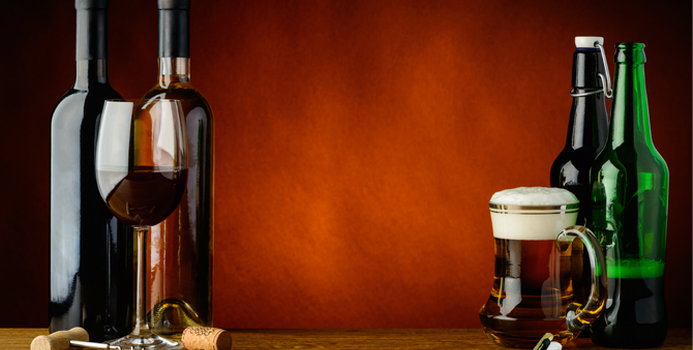Beer vs. wine: which should you order? Well, you should always order whatever you want! Some wines and beers are recommended for different types of meals and the reality is that most alcoholic beverages provide little, if any, nutritive value. In fact, alcohol can interfere with nutrient absorption and heavy drinkers may not get all the minerals and vitamins they consume. Alcohol is not digested but moves directly through the stomach lining and wall of the small intestine. If you eat food, you can slow the absorption of alcohol into the bloodstream, but once alcohol gets into the bloodstream it goes into every cell of the body, depressing some cellular activity. A healthy liver then detoxifies much of the alcohol consumed at about a half an ounce per hour, although the higher the blood alcohol concentration, the longer it takes. Women's bodies have less water than men's bodies do and since alcohol is carried in the body's fluids, not fat, the same amount of alcohol is more concentrated in women's blood streams and takes the liver longer to detox. Additionally, the enzyme that metabolizes alcohol is less active in women.
Potential benefits of alcohol use (besides enjoyment!) include lower risk of heart disease, mostly for middle-aged and older adults, and those studies showed that any alcoholic beverage, whether beer, wine or hard alcohol provided the benefits. Additionally, for those people who are suffering from small appetites, one alcoholic drink before a meal may stimulate an appetite and make the meal more appetizing, which may be an incentive for older adults.
Wine Choices
Wine is often chosen over beer because of health claims of protection against some diseases like heart disease. But there is no conclusive argument that it is any better if it is red wine or white wine or beer. The idea is that a small amount may help increase HDL blood cholesterol and it may further prevent bad cholesterol from forming. Another theory is that resveratrol may boost the body's clot dissolving enzyme. When blood clots, there is a decrease in blood flow which can lead to a heart attack or a stroke. Resveratrol is a flavonoid found in the skins and seed of grapes. Tannins, another phytonutrient in the wine, may also inhibit blood clotting.
Warning: If you are allergic to sulfites you need to either choose other beverages or sulfite-free wine.
Table Wine: typically has 7-14% alcohol.
Low-alcohol wine: wine or ferment fruit beverage with less than 7% alcohol. Be aware that it may have more sugar than regular wine.
Wine coolers: Best if made at home -- store bought wine coolers are often high in calories. Remember they are usually 12 ounces versus a regular 5-ounce glass of wine. They are diluted with added sugar, fruit juice and water or seltzer. Typically they contain less than 7% alcohol.
Fortified wine/Dessert wine: This is actually wine that had brandy or other hard alcohol added to it and the result is 14-24% alcohol.
Aperititf wine: This is also has brandy added and other herbs or flavorings. This wine has a 15-24% alcohol content.
Beer Choices
Sometimes people choose beer on a hot day, but remember that beer is not a good replacement for water because it works as mild diuretic, increasing urine output and so promoting dehydration. As with all alcohol, enjoying water between drinks is key. But that said, one study in the ADA Times found that drinking beer may lower the risk of kidney stones in men compared to other alcoholic beverages, possibly due to its high water content and its diuretic effects.
Regular beer: typically 4-6% alcohol.
Flavored malt beverage: A malt beverage may be made from a beer, porter, stout, ale, or lager and is flavored after fermentation. Flavors may be from fruit or other ingredients.
Low-alcohol beer: is a malt beverage with less than 2.5% alcohol.
Near beer: is a malt beverage that is blow .5% alcohol. Often sold as nonalcoholic beer.
|
Alcoholic Drink |
Calories |
|
12oz regular beer |
~150 |
|
12oz light beer |
~100 |
|
5oz dry wine |
~100 |
|
12oz wine cooler |
~180 |
So when you consider which beverage fits into your daily goals, ask the following questions:
- Which one will I enjoy more and which one will be more satisfying?
- Which one do I consume more slowly?
- Is an enjoyable lighter beer or wine choice available?
- Am I consuming alcohol in moderation?
Emily DeLacey MS, RD is a Registered Dietitian and currently working in Jamaica as a HIV/ AIDS Prevention Specialist. She attended Central Washington University for her Bachelor's Degree in Science and Dietetics and continued on after her internship to Kent State University for her Master's Degree in Science and Nutrition, with a focus on public health and advocacy. She served as a U.S. Peace Corps Volunteer in Malawi 2012-2014 working as a Community Health Advisor in a rural village, immersing in the joys of life without electricity or running water. She has been to 20+ countries and 47 of the 50 states in the US. Traveling, adventuring and experiencing new cultures has made her a passionate advocate for the equality of nutrition and wellness for all people.




